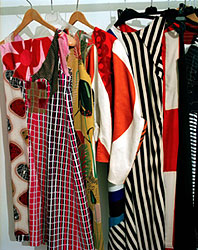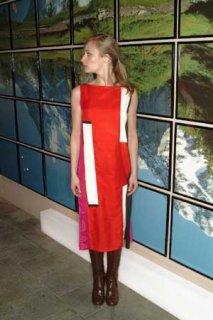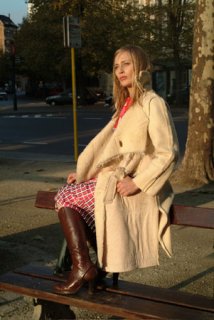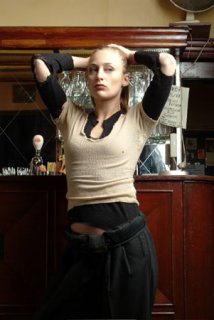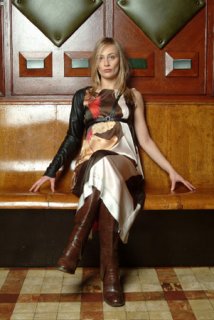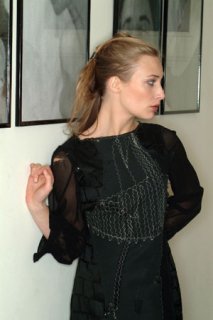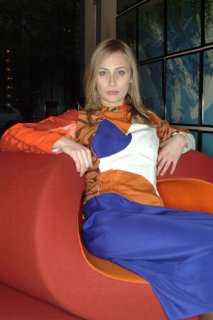Dries menswear (and his design overall) has a...secure, sweetness to its masculinity.
There was the comment that it lacks character--of course it does. It never strives to overshadow the man who wears it. You have to supply the character, the strength, the conversation. With him, god is in the details--the way the pockets are lined, a wool coat that buttons up like a waistcoat, a cotton pant blended just right to make it look like canvas, his 'in between' colours (black and brown, blue and purple), his unlined wool jackets that, somehow, still have structure...
He knows how to manipulate emotion and I relate to his artistic mastery of relying on memory (as other artists have and do--Toni Morrison, Van Gogh, Tori Amos, Faulkner, Sylvia Plath, Yada Yada). The clothes feel familiar, the cuts, the colours, the fabrics, even if you've never worn a coat cut like that in your life. Getting into the 'Belgian Fashion Design' book as well as Dries own book made me sell everything else in my closet. Now I only have Dries. And yes, it feels like it was made for me. And yes, it feels as if I've had it forever.
From Dries Van Noten 01...50:
On Design
"My designs have always had a very strong emphasis on texture. When your clothes emphasise texture, it makes sense to bring people close to the work, which is why our front rows are often so close together. In many fashion shows the catwalk is ten metres wide. Our front rows are sometimes only three metres apart, which makes it easy to 'feel' the clothes, to pick up lots of information."
"It's not that I'm afraid of modernity. It's just that if I have something old and beautiful, I treasure it. I always look to the future with respect for the past."
"Last winter, I made a print that started from an antique ribbon that I had found in an archive. I quite liked the movement of the design, so we enlarged it from a tiny thing, blew it up to one and a half metres, until all the small spots on the print became big dots. Once we have what we call these 'originals', these starting points, we start to work on those, until at the end you can no longer recognise the originals. Because if you do too much 'shopping' for your design ideas, it starts to look like you've been shopping, rather than designing."
"I've always been fascinated by things that I don't like. it's one of the principles that I've used quite often in my work: when you don't like a certain colour you try to work with it in such a way that, in the end, you end up liking it. You say to yourself, 'This colour I really don't like; it's not my colour.' But then you start to put it together with other colours, and in different materials, and at a certain moment you find that it looks quite interesting. I'm fascinated by that process. When you work only with things that are beautiful, it becomes too easy and soon gets very boring."
On Press
"The attitude of the press is very important; it can have a tremendous influence on how a show unfolds. If the press is uptight then it is almost impossible to have a good show. And when the press arrives, the journalists are often worried about their appearance, how their colleagues perceive them. There's always this period before the show starts, where they're all sitting there thinking, 'Is my scarf right? Is my bag right? Does my hair look OK?' So we go out of our way to disrupt this pattern. For example, as people enter the venue we will hand them a glass of Belgian beer and a carton of fries, and that changes the atmosphere immediately. You end up smiling, you drop your fries, you get ketchup on your coat, you spill your beer, you don't worry about your hair anymore."
Fashion Show No. 49 Men's Collection S/S 2005: 'Generation Clash - Scotland'
Food and drink: Martini, whisky and 1970s-style snacks
Instead of a conventional catwalk, several 'rooms' are set up in the cour vitree, and the audience sits on leather Chesterfields and armchairs sipping whisky and leafing through Playboy magazines - reminiscent of British gentlemen's clubs of the 70s or the smoking room in some randy prince's castle.
"The starting point," explains Dries, "was a clash of generations. Imagine Prince Harry, the naughty boy royal who likes a drink and a party, discovering the wardrobe of his ancestor the Duke of Windsor, and taking all those elgant clothes and styling them in a younger, more contemporary way.
Fashion Show No. 50 Women's Collection S/S 2005: 'Romanian Folklore'
Music: Bolero - Ravel
The 50th show takes place in a venue roughly the length of a football pitch. This enormous space houses a 120 metre table illuminated by Bohemian lead crystal chandeliers, with 250 guests on each side. A light supper is served, but before the meal is over the table becomes a catwalk, with everyone seated in the 'front row'...
"It's a nice way to bring everybody together," says the designer, "and reminiscent of the way people dance on the table when they're really having fun. It seemed very appropriate for his show, which is really a celebration."









 , only there were 6: Ann Demeulemeester, Dirk Bikkembergs, Dirk van Saene, Dries van Noten, Walter van Beirondonck, Marina Yee
, only there were 6: Ann Demeulemeester, Dirk Bikkembergs, Dirk van Saene, Dries van Noten, Walter van Beirondonck, Marina Yee


 ) from a couple of years ago. Both should still be available on amazon. The first one is the most comprehensive and concentrates on the 'first' generation; the second one only covers six of the new kids on the block (well, new at the time of publication! Veronique / X Delcour / Vandevorst etc...).
) from a couple of years ago. Both should still be available on amazon. The first one is the most comprehensive and concentrates on the 'first' generation; the second one only covers six of the new kids on the block (well, new at the time of publication! Veronique / X Delcour / Vandevorst etc...).
 .
. , don't know why.
, don't know why. ) couple their individual aesthetic with a strong business sense - you should not underestimate the difficulties of starting up a business without backing of any 'big' companies - and to keep going, like they've all done throughout the years. Myself being Flemish
) couple their individual aesthetic with a strong business sense - you should not underestimate the difficulties of starting up a business without backing of any 'big' companies - and to keep going, like they've all done throughout the years. Myself being Flemish  I would contribute it to a certain Flemish work aesthetic - hard work, very down to earth, and miles away from the bigheadedness you get in Paris, Milan or NY. Apart from their strong vision and academic background that's the other thing that made them visible - and popular.
I would contribute it to a certain Flemish work aesthetic - hard work, very down to earth, and miles away from the bigheadedness you get in Paris, Milan or NY. Apart from their strong vision and academic background that's the other thing that made them visible - and popular.

